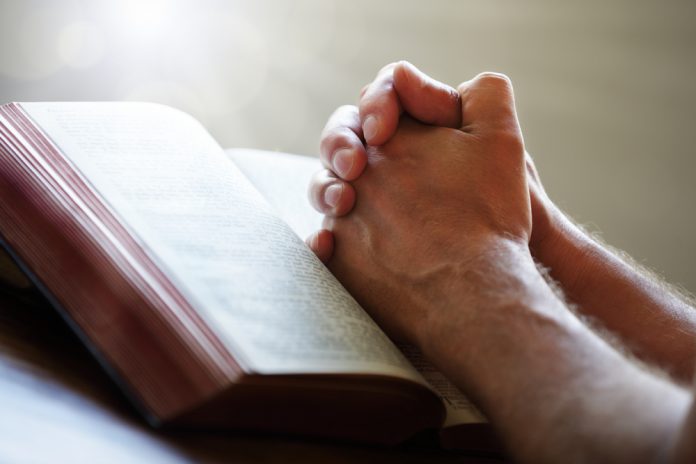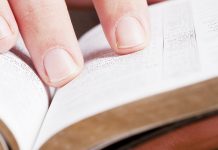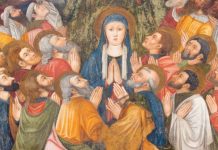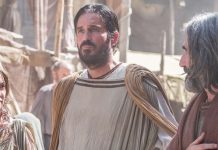
by Sister Lou Ella Hickman, IWBS
See the end of this article for more ideas about how to explore and learn about the Bible throughout the liturgical year.
One of the treasures in my community’s Heritage Room is a picture of a crucifix that dates back to before 1867. The artist formed the picture using very small French script to illustrate John’s account of the Passion of Jesus. The Church has an even more timeless treasure—the Bible. You can open the door of faith by exploring this treasure with your students.
Careful Planning
As you plan to explore and learn about the Bible with your students, decide on how much time you will allot to each class period for a Bible-focused activity. Even if you set aside only five to ten minutes of your class time every week for Bible literacy, you and your students can begin to understand why the Bible is truly the greatest story ever told. You might ask students what they want to learn about the Bible, and then incorporate their responses into the activities you choose.
Specific Suggestions
* Have students bring questions about the Bible to class—their own questions or questions their parents might have. If you cannot answer the questions, work as a group to find the answers. Keep a list of the questions and answers to review throughout the year.
* Review Sunday readings and select a verse or two for students to memorize. Have them work in pairs to help each other memorize the verses. Use rhymes and rhythms and rhythmic movements to help students memorize. You might also act out (perhaps in mime) scenes from one of the readings or the Gospel.
* Have students locate the Our Father in Matthew 6:9-13. Then explore ways you might help them learn to sign the Our Father. (Ask your pastor or DRE if anyone in the parish signs, and invite that person as a guest to teach the prayer. Or you might call your diocesan office for persons with disabilities to ask about resources for this activity.)
* Have students make booklets in which they illustrate important things people should know about the Bible. Have them title their booklets A Dozen Important Things to Know about the Bible. Give the booklets as gifts to people in your parish RCIA.
* Have students create a picture booklet of Bible stories to give to the First Communion classes.
* Hang a map of the Holy Land and the Middle East in your learning space, show short video clips of Bible lands, and locate the places on the maps.
* Have students find the names of ten countries where it is illegal to be a Christian or to be seen carrying a Bible. Post the list on poster board, then ask students to pray for the governments of those countries as well as for the safety of those who worship in hiding.
* Have students make bookmarks that show St. Jerome’s quote about Scripture: “Ignorance of Scripture is ignorance of Christ.” Give the bookmarks as gifts.
* Check YouTube (Part 1, Parts 2 & 3) for the scenes of parables in the movie Godspell. Show at least one and ask students how they might have portrayed it differently.
* If the stained glass windows in your parish church depict Bible scenes, have students study them to identify the scenes and then to locate the scenes in Scripture.
* Help students explore the maps, index, footnotes, and cross-references in their Bibles.
Sister Lou Ella is a spiritual director. She has a master’s degree in theology from St. Mary’s University in San Antonio, TX. For over 17 years, she taught at all levels and has served as a part-time librarian.
Explore and Learn about the Bible throughout the Liturgical Year
Advent/Christmas
* Have students write Bible verses from the nativity stories on narrow strips of holiday-colored construction paper. Connect the strips to create a nativity paper chain and hang the chain in the classroom or on the classroom Jesse tree or Christmas tree. This activity also can be done for Lent, the Triduum, and the Easter Season as well.
* Help students locate and become familiar with the Benedictus (Luke 1:68-79) and the Magnificat (Luke 1:46-55) in their Bibles, and help them to include these prayers in a presentation of the Nativity.
Lent
* Observe Holy Week by making crosses out of wooden clothes pins. Give students strips of paper on which you’ve typed portions of the Passion story. Have students arrange the account of the Passion by putting the crosses in the correct order. They may need to refer to their Bibles for this activity.
Easter Vigil
* Have students do a choral reading of one of the readings or psalms for the Mass if possible.
Easter season
* The Fourth Sunday of Easter is referred to as Good Shepherd Sunday. It is the World Day of Prayer for Vocations. Have students read about the vocational call of various people in the Old Testament (Moses. Exodus 3:4—4:17; Samuel, 1 Samuel 2:1-20; David, 1 Sameul16:1-13; Jeremiah, Jeremiah 1:4-5, 17-19) and in the New Testament (Jesus, Matthew 3:14-17; Paul, Acts 9:1-20; John the Baptist, Luke 1:1-20; Mary, Luke 1:26-56; the Apostles, Mark 3:13-19, also see Luke 6:12-16).
* Have students listen to “Worthy is the Lamb” (Revelation 5:12) from Handel’s Messiah. (YouTube® morphthing1 has words and music notations.)
* Help students find Psalm 150 in their Bibles and have them choreograph its joyful praise.
Pentecost
* If your parish is hosting a seminarian for his pastoral year, invite him to share with students the lessons he liked best in his classes on the Bible.
* Invite a young person who has just been confirmed to be your guest during class. Then read Acts 2:1-11 and ask the newly confirmed person to share his or her experience of learning about Confirmation and what being confirmed means in living as a Catholic.
Ordinary Time
* As a class, write a letter to the bishop/archbishop of your diocese/archdiocese to request a celebration of the Year of the Bible. Have students create artistic renditions of a possible logo that could represent the Year of the Bible. Include these expressions with the letter.
* Create a committee to study the possibility of a Bible literacy ministry.
* Have students act out, mime, or draw pictures of various verses from the Book of Proverbs.
* Have students research the biographies of people who are known for their great contributions to Scripture: Constantine, Charlemagne, Pope Gregory II, Jerome, Pope Pius XII.
* Research quotes by famous Catholics about the Bible.
Feast Days
* Feast of the Annunciation of the Lord (March 25): Have students locate and read Luke 1:1-25 and Luke 1:26-38 and retell the accounts in their own words.
* All Saints Day (November 1): Have students research biblical characters and dress up as them. Or have students write a Litany of the Saints using the names of people in the Bible. Consider including the song “When the Saints Go Marching In” as part of the litany.
* Christ the King (the last Sunday in the liturgical year): Have students carry the Bible in a solemn procession around the classroom, arriving at a prayer table where the Bible can be reverently enthroned.
For Catechists
* Each week make a list of three activities you are doing with your students to reinforce Bible literacy. Make enough copies to share with the other catechists in your program.
* Gather with other catechists to read and discuss the document Dei verbum (The Constitution on Divine Revelation).
Copyright 2013, Bayard, Inc. All rights reserved. This article is protected by United States copyright and other intellectual property laws and may not be reproduced, rewritten, distributed, redisseminated, transmitted, displayed, published or broadcast, directly or indirectly, in any medium without the prior written permission of Bayard, Inc.
This article was written by the Catechist Staff and appeared in Catechist magazine, January 2013.
Image Credit: Brian A Jackson/Shutter Stock 145450387




